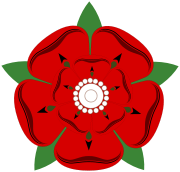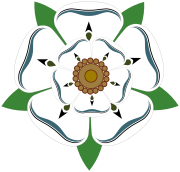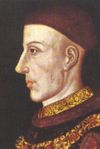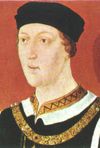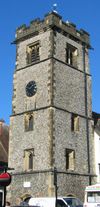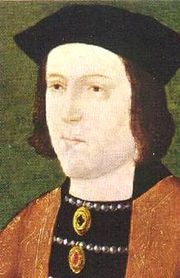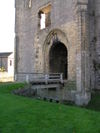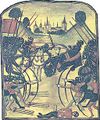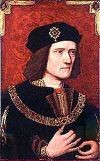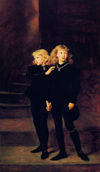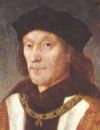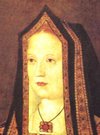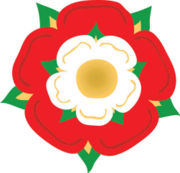Wars of the Roses
2007 Schools Wikipedia Selection. Related subjects: British History 1500 and before (including Roman Britain); Military History and War
The Wars of the Roses ( 1455 - 1485) were a series of civil wars fought over the throne of England between adherents of the House of Lancaster and the House of York. Both houses were branches of the Plantagenet royal house, tracing their descent from King Edward III.
The name "Wars of the Roses" was not used during the time of the wars, but has its origins in the badges associated with the two royal houses, the Red Rose of Lancaster and the White Rose of York. The term itself came into common usage only in the nineteenth century, after the publication of Anne of Geierstein by Sir Walter Scott. Scott based the name on a fictional scene in Shakespeare's play Henry VI Part 1, where the opposing sides pick different-coloured roses at the Temple Church.
Although the roses were occasionally used as symbols during the wars themselves, most of the participants wore badges associated with their immediate feudal lords or protectors. The unofficial system of Livery and Maintenance, by which powerful nobles would offer protection to followers who would sport their colours and badges (livery) was one of the effects of the breakdown of royal authority which preceded and partly caused the wars. For example, Henry's forces at Bosworth fought under the banner of a red dragon, whilst the Yorkist army used the symbol of a white boar.
The Wars were fought largely by the landed aristocracy and armies of feudal retainers; supporters of each house largely depended upon dynastic marriages with the nobility, feudal titles, and tenures. The Lancastrian patriarch John of Gaunt's first title was Earl of Richmond, the same title which Henry VII later held, whilst the Yorkist patriarch Edmund of Langley's first title was Earl of Cambridge.
| Wars of the Roses |
|---|
| 1st St Albans – Blore Heath – Ludford Bridge – Northampton – Wakefield – Mortimer's Cross – 2nd St Albans – Ferrybridge – Towton – Hedgeley Moor – Hexham – Edgecote Moor – Lose-coat Field – Barnet – Tewkesbury – Bosworth Field – Stoke Field |
The disputed succession
The antagonism between the two houses started with the overthrow of King Richard II by his cousin, Henry Bolingbroke, Duke of Lancaster, in 1399. As an issue of Edward III's third son John of Gaunt, Bolingbroke had a very poor claim to the throne. According to precedent, the crown should have passed to the male descendants of Lionel of Antwerp, Duke of Clarence (1338-1368), Edward III's second son, and in fact, Richard II had named Lionel's grandson, Roger Mortimer, 4th Earl of March as heir presumptive. However, Bolingbroke was crowned as Henry IV. He was tolerated as king since Richard II's government had been highly unpopular. Nevertheless, within a few years of taking the throne, Henry found himself facing several rebellions in Wales, Cheshire and Northumberland, which used the Mortimer claim to the throne both as pretext and rallying point. All these revolts were suppressed.
Henry IV died in 1413. His son and successor, Henry V, was a great soldier, and his military success against France in the Hundred Years' War bolstered his enormous popularity, enabling him to strengthen the Lancastrian hold on the throne.
Henry V's short reign saw one conspiracy against him, the Southampton Plot led by Richard, Earl of Cambridge, a son of Edmund of Langley, the fifth son of Edward III. Cambridge was executed in 1415 for treason at the start of the campaign leading up to the Battle of Agincourt. Cambridge's wife, Anne Mortimer, also had a claim to the throne, being the daughter of Roger Mortimer and thus a descendant of Lionel of Antwerp. Henry V died in 1422, and Richard, Duke of York, the son of Richard, Earl of Cambridge and Anne Mortimer, grew up to challenge his successor, the feeble King Henry VI, for the crown.
Henry VI
The Lancastrian King Henry VI of England was surrounded by unpopular regents and advisors. The most notable of these were Edmund Beaufort, 2nd Duke of Somerset and William de la Pole, 1st Duke of Suffolk, who were blamed for mismanaging the government and poorly executing the continuing Hundred Years' War with France. Under Henry VI, virtually all English holdings in France, including the land won by Henry V, were lost. Henry VI was seen as a weak, ineffectual king. In addition, he suffered from episodes of mental illness which he had possibly inherited from his grandfather Charles VI of France. By the 1450s, many considered Henry incapable. The Lancastrian kings had been plagued by questions of legitimacy, and the House of York believed that it had a stronger claim to the throne.
The increasing discord at court was mirrored in the country as a whole, where noble families engaged in private feuds and showed increasing disrespect for the royal authority and for the courts. The Percy-Neville feud was the best-known of these private wars, but others were being conducted freely. In many cases they were fought between old-established families, and formerly minor nobility raised in power and influence by Henry IV in the aftermath of the rebellions against him. The quarrel between the Percies, for long the Dukes of Northumberland, and the comparatively upstart Nevilles was one which followed this pattern; another was the feud between the Courtenays and Bonvilles in Cornwall.
A factor in these feuds was apparently the presence of large numbers of soldiers discharged from the English armies in France. Nobles engaged many of these to mount raids, or to pack courts of justice with their supporters, intimidating suitors, witnesses and judges.
This growing civil discontent, the abundance of feuding nobles with private armies, and corruption in Henry VI's court formed a political climate ripe for civil war.
In 1453, Henry suffered the first of several bouts of mental illness, so a Council of Regency was set up, headed by the powerful and popular Richard Plantagenet, Duke of York and head of the House of York as Lord Protector. Richard soon asserted his power with ever-greater boldness (although there is no proof that he had aspirations to the throne at this early stage). He imprisoned Somerset; and backed his allies, Salisbury and Warwick, in a series of minor conflicts with powerful supporters of Henry, such as the Dukes of Northumberland. Henry's recovery in 1455 thwarted Richard's ambitions, and the Duke of York was forced out of the royal court by Henry's queen, Margaret of Anjou. Since Henry was an ineffectual leader, the powerful and aggressive Queen Margaret emerged as the de facto leader of the Lancastrians. Margaret built up an alliance against Richard and conspired with other nobles to reduce his influence. An increasingly thwarted Richard finally resorted to armed hostilities in 1455 at the First Battle of St Albans.
The initial phase 1455–60
Although armed clashes had occurred previously between supporters of Henry and Richard, the principal period of armed conflict in the Wars of the Roses took place between 1455 and 1489.
Richard, Duke of York led a small force toward London and was met by Henry's forces at St Albans, north of London, on May 22, 1455. The relatively small First Battle of St Albans was the first open conflict of the civil war. Richard's aim was ostensibly to remove "poor advisors" from King Henry's side. The result was a Lancastrian defeat. Several prominent Lancastrian leaders, including Somerset, were lost. York and his allies regained their position of influence, and for a while both sides seemed shocked that an actual battle had been fought and did their best to reconcile their differences. When Henry suffered another bout of mental illness, York was again appointed Protector, and Margaret was shunted aside, charged with the king's care.
After the first Battle of St Albans, the compromise of 1455 enjoyed some success, with York remaining the dominant voice on the Council even after Henry's recovery. The problems which had caused conflict soon re-emerged, particularly the issue of whether the Duke of York, or Henry and Margaret's infant son, Edward, would succeed to the throne. Margaret refused to accept any solution that would disinherit her son, and it became clear that she would only tolerate the situation for as long as the Duke of York and his allies retained the military ascendancy. Henry went on royal progress in the Midlands in 1456, and Margaret did not allow him to return to London — the king and queen were popular in the Midlands but becoming ever more unpopular in London where merchants were angry at the decline in trade and widespread disorder. The king's court set up at Coventry. By then, the new Duke of Somerset was emerging as a favourite of the royal court, filling his father's shoes. Margaret also persuaded Henry to dismiss the appointments York had made as Protector, while York himself was made to return to his post in Ireland. Disorder in the capital and piracy on the south coast were growing, but the king and queen remained intent on protecting their own positions, with the queen introducing conscription for the first time in England. Meanwhile, York's ally, Richard Neville, Earl of Warwick (later dubbed "The Kingmaker"), was growing in popularity in London as the champion of the merchant grounds.
Following York's return from Ireland, hostilities resumed on September 23, 1459, at the Battle of Blore Heath in Staffordshire, when a large Lancastrian army failed to prevent a Yorkist force under Lord Salisbury from marching from Middleham Castle in Yorkshire and linking up with York at Ludlow Castle. After a Lancastrian victory at the Battle of Ludford Bridge, Edward, Earl of March (York's eldest son, later Edward IV of England), Salisbury, and Warwick fled to Calais. The Lancastrians were now back in total control, and Somerset was sent off to be Governor of Calais. His attempts to evict Warwick were easily repulsed, and the Yorkists even began to launch raids on the English coast from Calais in 1459–60, adding to the sense of chaos and disorder.
In 1460, Warwick and the others launched an invasion of England, and rapidly established themselves in Kent and London, where they enjoyed wide support. Backed by a papal emissary who had taken their side, they marched north. Henry led an army south to meet them while Margaret remained in the north with Prince Edward. The Battle of Northampton, on July 10, 1460, proved disastrous for the Lancastrians. The Yorkist army under the Earl of Warwick, aided by treachery in the Lancastrian ranks, was able to capture King Henry and take him prisoner to London.
The Act of Accord
In the light of this military success, York now moved to press his claim to the throne based on the illegitimacy of the Lancastrian line. Landing in north Wales, he and his wife Cecily entered London with all the ceremony usually reserved for a monarch. Parliament was assembled, and when York entered he made straight for the throne, which he may have been expecting the Lords to encourage him to take for himself as they had Henry IV in 1399. Instead, there was stunned silence. He announced his claim to the throne, but the Lords, even Warwick and Salisbury, were shocked by his presumption; they had no desire at this stage to overthrow King Henry. Their ambition was still limited to the removal of his bad councillors.
The next day, York produced detailed genealogies to support his claim based on his descent from Lionel of Antwerp and was met with more understanding. Parliament agreed to consider the matter and accepted that York's claim was better; but, by a majority of five, they voted that Henry should remain as king. A compromise was struck in October 1460 with the Act of Accord, which recognised York as Henry's successor, disinheriting Henry's six year old son, Edward. York accepted this compromise as the best on offer; it gave him much of what he wanted, particularly since he was also made Protector of the Realm and was able to govern in Henry's name. Margaret was ordered out of London with Prince Edward. The Act of Accord proved unacceptable to the Lancastrians, who rallied to Margaret, forming a large army in the north.
Lancastrian counter-attack
The Duke of York left London later that year with Lord Salisbury to consolidate his position in the north against Margaret's army, reported to be massing near the city of York. Richard took up a defensive position at Sandal Castle near Wakefield at Christmas 1460. Although Margaret's army outnumbered Richard's by more than two to one, on December 30 York ordered his forces to leave the castle and mount an attack. His army was dealt a devastating defeat at the Battle of Wakefield. Richard was slain in the battle, and Salisbury and Richard's 17-year-old son, Edmund, Earl of Rutland, were captured and beheaded. Margaret ordered the heads of all three placed on the gates of York. This event, or the later defeat of Richard III, later inspired the mnemonic "Richard Of York Gave Battle In Vain" for the seven colours of the rainbow.
The Act of Accord and the events of Wakefield left the 18-year-old Edward, Earl of March, York's eldest son, as Duke of York and heir to the throne. Salisbury's death left Warwick, his heir, as the biggest landowner in England. Margaret travelled to Scotland to negotiate for Scottish assistance. Mary of Gueldres, Queen of Scotland agreed to give Margaret an army on condition that she cede the town of Berwick to Scotland and her daughter be betrothed to Prince Edward. Margaret agreed, although she had no funds to pay her army and could only promise booty from the riches of southern England, as long as no looting took place north of the river Trent. She took her army to Hull, recruiting more men as she went.
Edward of York, meanwhile, met Pembroke's army, arriving from Wales, and defeated them soundly at the Battle of Mortimer's Cross in Herefordshire. He inspired his men with a "vision" of three suns at dawn (a phenomenon known as " parhelion"), telling them that it was a portent of victory and represented the three surviving York sons — himself, George and Richard. This led to Edward's later adoption of the sign of the sunne in splendour as his personal emblem.
Margaret was now moving south, wreaking havoc as she progressed, her army supporting itself by looting as it passed through the prosperous south of England. In London, Warwick used this as propaganda to reinforce Yorkist support throughout the south — the town of Coventry switching allegiance to the Yorkists. Warwick failed to start raising an army soon enough and, without Edward's army to reinforce him, was caught off-guard by the Lancastrians' early arrival at St Albans. At the Second Battle of St Albans the queen won the Lancastrians' most decisive victory yet, and as the Yorkist forces fled they left behind King Henry, who was found unharmed under a tree. Henry knighted thirty Lancastrian soldiers immediately after the battle. As the Lancastrian army advanced southwards, a wave of dread swept London, where rumours were rife about savage Northerners intent on plundering the city. The people of London shut the city gates and refused to supply food to the queen's army, which was looting the surrounding counties of Hertfordshire and Middlesex.
Yorkist triumph
Meanwhile, Edward was advancing towards London from the west where he had joined forces with Warwick. This coincided with the northward retreat by the queen to Dunstable, allowing Edward and Warwick to enter London with their army. They were welcomed with enthusiasm, money and supplies by the largely Yorkist-supporting city. Edward could no longer claim simply to be trying to wrest the king from bad councillors. With his father and brother having been killed at Wakefield, this had become a battle for the crown itself. Edward now needed authority, and this seemed forthcoming when the Bishop of London asked the people of London their opinion and they replied with shouts of "King Edward". This was quickly confirmed by Parliament and Edward was unofficially crowned in a hastily arranged ceremony at Westminster Abbey amidst much jubilation. Edward and Warwick thus captured London, although Edward vowed he would not have a formal coronation until Henry and Margaret were executed or exiled. He also announced that Henry had forfeited his right to the crown by allowing his queen to take up arms against his rightful heirs under the Act of Accord; though it was by now becoming widely argued that Edward's victory was simply a restoration of the rightful heir to the throne, which neither Henry nor his Lancastrian predecessors had been. It was this argument which Parliament had accepted the year before.
Edward and Warwick marched north, gathering a large army as they went, and met an equally impressive Lancastrian army at Towton. The Battle of Towton, near York, was the biggest battle of the Wars of the Roses thus far. Both sides agreed beforehand that the issue was to be settled that day, with no quarter asked or given. An estimated 40-80,000 men took part with over 20,000 men being killed during (and after) the battle, an enormous number for the time and the greatest recorded single day's loss of life on English soil. Edward and his army won a decisive victory, the Lancastrians were routed, with most of their leaders slain. Henry and Margaret, who were waiting in York with their son Edward, fled north when they heard of the outcome. Many of the surviving Lancastrian nobles now switched allegiance to King Edward, and those who did not were driven back to the northern border areas and a few castles in Wales. Edward advanced to take York where he was confronted with the rotting heads of his father, his brother and Salisbury, which were soon replaced with those of defeated Lancastrian lords like the notorious John Clifford, 9th Baron de Clifford of Skipton-Craven, who was blamed for the execution of Edward's brother Edmund, Earl of Rutland, after the Battle of Wakefield.
Henry and Margaret fled to Scotland where they stayed with the court of James III, implementing their earlier promise to cede Berwick to Scotland and leading an invasion of Carlisle later in the year. But lacking money, they were easily repulsed by Edward's men who were rooting out the remaining Lancastrian forces in the northern counties.
Edward IV's official coronation took place in June 1461 in London where he received a rapturous welcome from his supporters as the new king of England. Edward was able to rule in relative peace for ten years.
In the North, Edward could never really claim to have complete control until 1464, as apart from rebellions, several castles with their Lancastrian commanders held out for years. Dunstanburgh, Alnwick (the Percy family seat) and Bamburgh were some of the last to fall. Last to surrender was the mighty fortress of Harlech (Wales) in 1468 after a seven-year-long siege. The deposed King Henry was captured in 1465 and held prisoner at the Tower of London where, for the time being, he was reasonably well treated.
There were two further Lancastrian revolts in 1464. The first clash was at the Battle of Hedgeley Moor on April 25 and the second at the Battle of Hexham on May 15. Both revolts were put down by Warwick's brother, John Neville, 1st Marquess of Montagu.
Resumption of hostilities 1469–71
The period 1467–70 saw a marked and rapid deterioration in the relationship between King Edward and his former mentor, the powerful Richard Neville, Earl of Warwick — "the Kingmaker". This had several causes, but stemmed originally from Edward's decision to marry Elizabeth Woodville in secret in 1464. Edward later announced that, the news of his marriage as fait accompli, to the considerable embarrassment of Warwick, who had been negotiating a match between Edward and a French bride, convinced as he was of the need for an alliance with France. This embarrassment turned to bitterness when the Woodvilles came to be favoured over the Nevilles at court. Other factors compounded Warwick's disillusionment: Edward's preference for an alliance with Burgundy (over France), and Edward's reluctance to allow his brothers George, Duke of Clarence, and Richard, Duke of Gloucester, to marry Warwick's daughters, Isabel Neville and Anne Neville, respectively. Furthermore, Edward's general popularity was also on the wane in this period with higher taxes and persistent disruptions of law and order.
By 1469 Warwick had formed an alliance with Edward's jealous and treacherous brother George. They raised an army which defeated the King at the Battle of Edgecote Moor, and held Edward at Middleham Castle in Yorkshire. Warwick had the queen's father, Richard Woodville, 1st Earl Rivers, executed. He forced Edward to summon a parliament at York at which it was planned that Edward would be declared illegitimate and the crown would thus pass to George, Duke of Clarence as Edward's heir apparent. However, the country was in turmoil, and Edward was able to call on the loyalty of his brother Richard, Duke of Gloucester, and the majority of the nobles. Richard arrived at the head of a large force and liberated the king.
Warwick and Clarence were declared traitors and forced to flee to France, where in 1470 Louis XI of France was coming under pressure from the exiled Margaret of Anjou to help her invade England and regain her captive husband's throne. It was King Louis who suggested the idea of an alliance between Warwick and Margaret, a notion which neither of the old enemies would at first entertain but eventually came round to, realising the potential benefits. However, both were undoubtedly hoping for different outcomes: Warwick for a puppet king in the form of Henry or his young son; Margaret to be able to reclaim her family's realm. In any case, a marriage was arranged between Warwick's daughter Anne Neville and Margaret's son, the former Prince of Wales, Edward of Westminster, and Warwick invaded England in the autumn of 1470.
This time it was Edward IV who was forced to flee the country when John Neville changed loyalties to support his brother Warwick. Edward was unprepared for the arrival of Neville's large force from the north and had to order his army to scatter. Edward and Gloucester fled from Doncaster to the coast and thence to Holland and exile in Burgundy. Warwick had already invaded from France, and his plans to liberate and restore Henry VI to the throne came quickly to fruition. Henry VI was paraded through the streets of London as the restored king in October and Edward and Richard were proclaimed traitors. Warwick's success was short-lived, however. He overreached himself with his plan to invade Burgundy with the king of France, tempted by King Louis' promise of territory in the Netherlands as a reward. This led Charles the Bold of Burgundy to assist Edward. He provided funds and an army to launch an invasion of England in 1471. Edward defeated Warwick at the Battle of Barnet in 1471. The remaining Lancastrian forces were destroyed at the Battle of Tewkesbury, and Prince Edward of Westminster, the Lancastrian heir to the throne, was killed. Henry VI was murdered shortly afterwards ( May 14, 1471), to strengthen the Yorkist hold on the throne.
Richard III
The restoration of Edward IV in 1471 is sometimes seen as marking the end of the Wars of the Roses. Peace was restored for the remainder of Edward's reign, but when he died suddenly in 1483, political and dynastic turmoil erupted again. Under Edward IV, factions had developed between the Queen's Woodville relatives ( Anthony Woodville, 2nd Earl Rivers and Thomas Grey, 1st Marquess of Dorset) and others who resented the Woodvilles' new-found status at court and saw them as power-hungry upstarts and parvenus. At the time of Edward's premature death, his heir, Edward V, was only 12 years old. The Woodvilles were in a position to influence the young king's future government, since Edward V had been brought up under the stewardship of Earl Rivers in Ludlow. This was too much for many of the anti-Woodville faction to stomach, and in the struggle for the protectorship of the young king and control of the council, Edward's brother Richard, Duke of Gloucester, who had been named by Edward IV on his deathbed as Protector of England, came to be de facto leader of the anti-Woodville faction.
With the help of William Hastings and Henry Stafford, Gloucester captured the young king from the Woodvilles at Stony Stratford in Buckinghamshire. Thereafter Edward V was kept under Gloucester's custody in the Tower of London, where he was later joined by his younger brother, the 9-year-old Richard, Duke of York. Having secured the boys, Richard then alleged that Edward IV's marriage to Elizabeth Woodville had been illegal, and that the two boys were therefore illegitimate. Parliament agreed and enacted the Titulus Regius, which officially named Gloucester as King Richard III. The two imprisoned boys, known as the " Princes in the Tower", disappeared and were possibly murdered; by whom and under whose orders remains one of the most controversial subjects in English history.
Since Richard was the finest general on the Yorkist side, many accepted him as a ruler better able to keep the Yorkists in power than a boy who would have had to rule through a committee of regents. Lancastrian hopes, on the other hand, now centred on Henry Tudor, whose father, Edmund Tudor, 1st Earl of Richmond, had been a half-brother of Henry VI. However, Henry's claim to the throne was through his mother, Margaret Beaufort, a descendant of Edward III, derived from John Beaufort, a grandson of Edward III's as the illegitimate son of John of Gaunt (at birth though later legitimated on the marriage of his parents).
Henry Tudor
Henry Tudor's forces defeated Richard's at the Battle of Bosworth Field in 1485 and Henry Tudor became King Henry VII of England. Henry then strengthened his position by marrying Elizabeth of York, daughter of Edward IV and the best surviving Yorkist claimant. He thus reunited the two royal houses, merging the rival symbols of the red and white roses into the new emblem of the red and white Tudor Rose. Henry shored up his position by executing all other possible claimants whenever he could lay hands on them, a policy his son, Henry VIII, continued.
Many historians consider the accession of Henry VII to mark the end of the Wars of the Roses. Others argue that the Wars of the Roses concluded only with the Battle of Stoke in 1487, which arose from the appearance of a pretender to the throne, a boy named Lambert Simnel who bore a close physical resemblance to the young Earl of Warwick, the best surviving male claimant of the House of York. The pretender's plan was doomed from the start, because the young earl was still alive and in King Henry's custody, so no one could seriously doubt Simnel was anything but an imposter. At Stoke, Henry defeated forces led by John de la Pole, Earl of Lincoln — who had been named by Richard III as his heir, but had been reconciled with Henry after Bosworth — thus effectively removing the remaining Yorkist opposition. Simnel was pardoned for his part in the rebellion and sent to work in the royal kitchens. Henry's throne was again challenged with the appearance of the pretender Perkin Warbeck who, in 1491 claimed to be Richard, Duke of York. Henry consolidated his power in 1499 with the capture and execution of Warbeck.
Aftermath
Although historians still debate the true extent of the conflict's impact on medieval English life, there is little doubt that the Wars of the Roses resulted in massive political upheaval and huge changes to the established balance of power. The most obvious effect was the collapse of the Plantagenet dynasty and its replacement with the new Tudor rulers who were to change England dramatically over the following years. In the following Henrician and post-Henrician times the remnant Plantagenet factions with no direct line to the throne were disabused of their independent positions, as monarchs continually played them off against each other.
With their heavy casualties among the nobility, the wars are thought to have ushered in a period of great social upheaval in feudal England, including a weakening of the feudal power of the nobles and a corresponding strengthening of the merchant classes, and the growth of a strong, centralized monarchy under the Tudors. It heralded the end of the medieval period in England and the movement towards the Renaissance.
On the other hand, it has also been suggested that traumatic impact of the wars was exaggerated by Henry VII, to magnify his achievement in quelling them and bringing peace. Certainly, the effect of the wars on the merchant and labouring classes was far less than in the long drawn-out wars of siege and pillage in France and elsewhere in Europe, carried out by mercenaries who profited from the prolongation of the war. Although there were some lengthy sieges, such as at Harlech Castle and Bamburgh Castle, these were in remote and sparsely-inhabited regions. In the populated areas, both factions had much to lose by the ruin of the country, and sought quick resolution of the conflict by pitched battle.
The war was disastrous for England's already declining influence in France, and by the end of the struggle few of the gains made over the course of the Hundred Years' War remained, apart from Calais which eventually fell during the reign of Queen Mary. Although later English rulers would continue to campaign on the continent, England's territories were never reclaimed. Indeed, various duchies and kingdoms in Europe played a pivotal role in the outcome of the war; in particular the kings of France and the dukes of Burgundy played the two factions off each other, pledging military and financial aid and offering asylum to defeated nobles to prevent a strong and unified England making war on them.
The post-war period was also the death knell for the large standing baronial armies, which had helped fuel the conflict. Henry, wary of any further fighting, kept the barons on a very tight leash, removing their right to raise, arm, and supply armies of retainers so that they could not make war on each other or the king. England would not see another standing army until Cromwell's New Model Army. As a result the military power of individual barons declined, and the Tudor court became a place where baronial squabbles were decided with the influence of the monarch.
In fiction
Shakespeare's plays on Henry VI, parts 1, 2, and 3, and his Richard III cover the period of the wars. Henry VI, part 1 includes a scene in the Temple church where the dispute between the two houses begins, giving the conflict its modern name:
| “ |
"And here I prophesy: this brawl today, |
” |
- Sir Walter Scott's Anne of Geierstein concerns exiled English Lancastrians in 15th century Burgundy and Switzerland
- Robert Louis Stevenson's The Black Arrow is set during the war; the hero is a young Yorkist nobleman
- Historical-romantic novel 'The Sunne in Splendour', by Sharon Kay Penman. This book of more than 900 pages gives a detailed account of the whole war in a historically and chronologically accurate way. The author has made additions and minor adjustments to enrich the story, however.
- A rich and highly praised account of the Wars of the Roses appears in a recently published multiple-award-winning novel, 'The Rose of York: Love & War' by Sandra Worth. The book has been noted for its meticulous research by the Richard III Society
- In "The Warrior Heir" by Cinda WIlliams Chima the main character, Jack, is brought into a battle between modern day Roses: guilds of wizards pitting the lives of Magical Warriors (of which Jack is one) in battle to claim a throne of leader ship over the other Roses
- In the PS2 game " Yu-Gi-Oh! The Duelists of the Roses" the characters of the popular Yu-Gi-Oh! series embark on either sides of the red or white roses in a historically accurate quest
- The dynastic feuding in The Deep, the first novel by John Crowley, is modeled on the Wars of the Roses.
- George R.R. Martin's A Song of Ice and Fire, particularly its first book, is loosely based on the War of the Roses. Martin's Lannister family represents the Lancastrians while the Starks represent the Yorkists
- In the Playstation game Final Fantasy Tactics the plot revolves around the Lion War, a war of succession modelled after the Wars of the Roses
- In "Alice In Wonderland", the Queen's cards are painting white roses with red paint while singing "We're painting the roses red…" (This is an allusion to the Lancastrian victory over the Yorks)
- In James Joyce's A Portrait of the Artist as a Young Man, the character Stephen Dedalus competes with a fellow student, Jack Lawton, in working sums. Stephen wears a white rose and Lawton a red, and their prefect shouts, "Now then, who will win? Go ahead, York! Go ahead, Lancaster!"
Key figures
The following is a simplified family tree including members of the English royal family.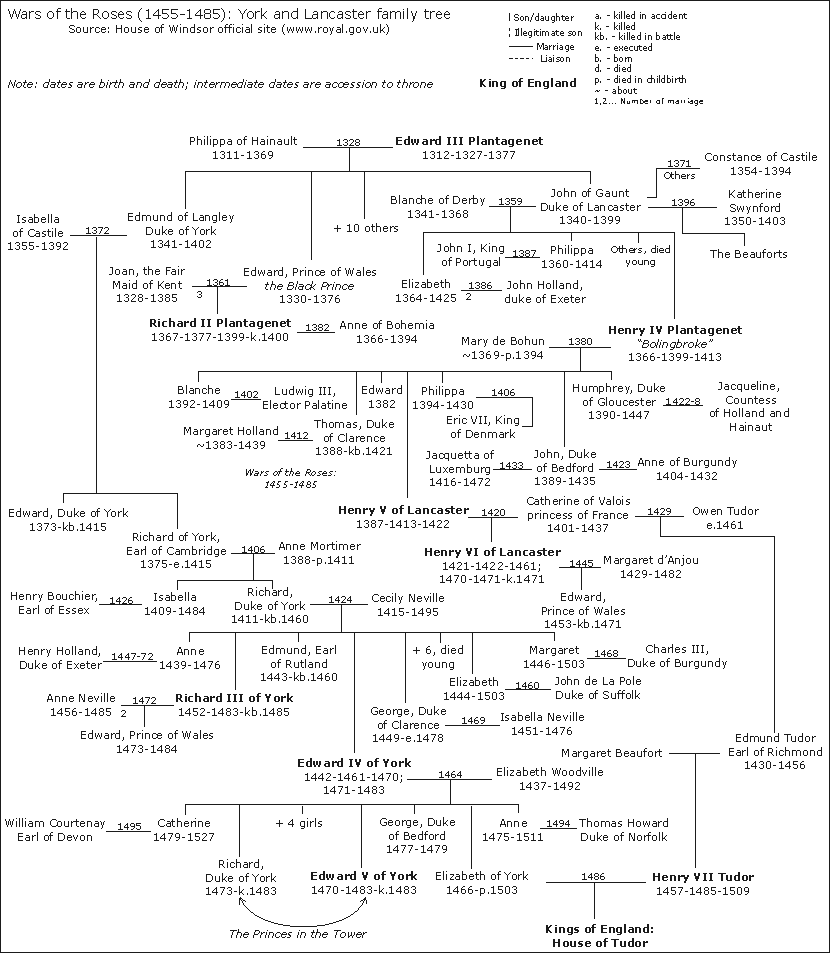
Articles
- Kings of England
- Henry VI (Lancastrian)
- Edward IV (Yorkist)
- Edward V (Yorkist)
- Richard III (Yorkist)
- Henry VII (Tudor)
- Prominent antagonists 1455–87
- Yorkist
- Richard Plantagenet, 3rd Duke of York
- Richard Neville, 16th Earl of Warwick ('The Kingmaker')
- Richard Neville, 5th Earl of Salisbury
- John Neville, 1st Marquess of Montagu
- William Neville, 1st Earl of Kent
- Bastard of Fauconberg
- Lancastrian
- Margaret of Anjou Queen to Henry VI
- Sir Henry Percy, 2nd Earl of Northumberland
- Henry Percy, 3rd Earl of Northumberland
- Richard Neville, 16th Earl of Warwick ('The Kingmaker')
- Edmund Beaufort, 2nd Duke of Somerset
- Henry Beaufort, 3rd Duke of Somerset
- Yorkist
- Earl of Pembroke
- Lord Clifford
Battles
- First Battle of St Albans - May 22, 1455 (Yorkist victory)
- Battle of Blore Heath - September 23, 1459 (Yorkist victory)
- Battle of Ludford Bridge - October 12, 1459 (Lancastrian victory)
- Battle of Northampton (1460) - July 10, 1460 (Yorkist victory)
- Battle of Wakefield - December 30, 1460 (Lancastrian victory)
- Battle of Mortimer's Cross - February 2, 1461 (Yorkist victory)
- Second Battle of St Albans - February 22, 1461 (Lancastrian victory)
- Battle of Ferrybridge - March 28, 1461 (Indecisive)
- Battle of Towton - March 29, 1461 (Yorkist victory)
- Battle of Hedgeley Moor - April 25, 1464 (Yorkist victory)
- Battle of Hexham - May 15, 1464 (Yorkist victory)
- Battle of Edgecote Moor - July 26, 1469 (Lancastrian victory)
- Battle of Lose-coat Field - March 12, 1470 (Yorkist victory)
- Battle of Barnet - April 14, 1471 (Yorkist victory)
- Battle of Tewkesbury - May 4, 1471 (Yorkist victory)
- Battle of Bosworth Field - August 22, 1485 (Lancastrian victory)
- Battle of Stoke Field - June 16, 1487 (Lancastrian victory)
